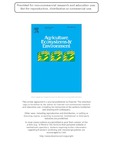Assessing and modeling the role of the native legume Lupinus meridanus in fertility restoration in a heterogeneous mountain environment of the tropical Andes

View/
Date
2012Palabras Clave
Long fallow agriculture, Nitrogen fixation, Andes, Succession modeling, Environmental heterogeneity, PotatoMetadata
Show full item recordAbstract
The role of the native legume Lupinus meridanus on fertility restoration in long fallow agriculture of the Venezuelan Andes was analyzed using field and laboratory data and a process-based model of succession (FAPROM). L. meridanus biomass was estimated in 117 plots with 1-12 years in fallow and N2 fixation was calculated using the natural 15N abundance. Additionally, the legume was sowed at the beginning of the fallow period in three plots and, after two years, its effect on a posterior potato crop was evaluated. FAPROM was used to simulate L. meridanus development and N2 fixation during the fallow period in competition with other five species; after the early introduction of the legume; and in L. meridanus monoculture.
High biomass variability between plots of the same age was observed in the field (coefficients of variability exceeding 100%). In consequence, the estimated N2 fixation was also variable, increasing during the fallow period to attain a maximum after five years (1.36 ± 2.84 g N m-2 year-1) and decreasing afterwards. Cumulative fixation after 10 years in fallow was estimated in 4 g m-2, a modest contribution to fertility restoration. Nevertheless, this cumulative value rose to 23.5 g m-2 when the potential fixation was estimated considering the plot of each fallow age where L. meridanus attained its highest biomass. FAPROM was modified to include two stochastic sources of variability, in initial soil organic N and in
the probability of colonization of the different species, and succeeded to reproduce mean values and the variability in L. meridanus biomass and N2 fixation. Model and experimental data indicate that the early introduction of the legume is a promising strategy to improve potato production and shorten the fallow period. This species has a high potential to fix N2 but its performance is hampered by the low probability of plot colonization.
Collections
Información Adicional
| Correo Electrónico | lsarmien@ula.ve |
| Editor | Agriculture, Ecosystems and Environment 159 (2012) 29-39 |
| Descripción | Agriculture, Ecosystems and Environment 159 (2012) 29-39 journal homepage: www.elsevier.com/lo cate/agee |
| Colación | 29-39 |
| Institución | Universidad de Los Andes |





